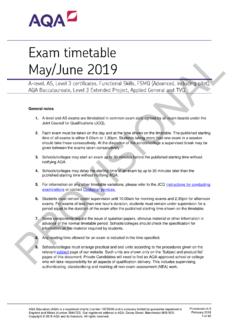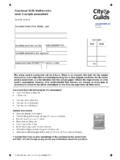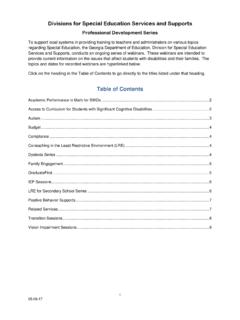Transcription of MEASURING STUDENT KNOWLEDGE AND SKILLS - …
1 Are students well prepared to meet the challenges of the future? Parents,students, the public and those who run education systems need to know whetherchildren are acquiring the necessary SKILLS and KNOWLEDGE to become tomorrow'scitizens and to continue learning throughout life. International indicators can describethe levels of achievement in various countries, to which others might aspire. They canprovide direction for schools' instructional efforts and for students' learning as well asinsights into curriculum strengths and 29 Member countries of the OECD, together with other countries, havelaunched the OECD Programme for International STUDENT assessment (PISA) todevelop such indicators on a regular basis.
2 PISA aims at assessing how far studentsapproaching the end of compulsory education have acquired some of the knowledgeand SKILLS that are essential for full participation in society. A New Framework for assessment ,the first volume in the PISA series, providesthe conceptual framework on which the PISA 2000 assessment is based. It defines thedomains of reading literacy, mathematics literacy and scientific literacy forming thecore of PISA in terms of the content that students need to acquire, the processes thatneed to be performed, and the contexts in which KNOWLEDGE and SKILLS are applied. Italso describes the methods developed to ensure that the assessment tasks are validacross countries, are strong at MEASURING relevant SKILLS and are based on authentic lifesituations.
3 MEASURING STUDENT KNOWLEDGE and SkillsA New Framework for assessment (96 1999 05 1 P) FF 150 ISBN 92-64-17053-79:HSTCQE=V\UZX\:OECD-99 ORGANISATION FOR ECONOMIC CO-OPERATION AND DEVELOPMENTM easuringStudent Knowledgeand SkillsMeasuringStudent Knowledgeand SkillsA New Frameworkfor AssessmentOECD PROGRAMME FOR INTERNATIONAL STUDENT ASSESSMENTThe OECD Programme for International STUDENT assessment (PISA) PISA is a collaborative process, bringing together scientific expertise from theparticipating countries and steered jointly by their governments on the basis ofshared, policy-driven interests. Key characteristics of PISA make it anunprecedented effort to measure students literacy: A long-term commitment: spanning over the decade to come, it will enablecountries to monitor continously their progress.
4 Future volumes in this serieswill focus on the tests themselves, the results of which will be published and updated every three years. The age-group covered: the 15-year-olds. Assessing young people near the endof their compulsory schooling provides a significant indication of educationalsystems performances. The literacy approach: KNOWLEDGE , SKILLS and competencies are not tested in terms of school curricula but rather in terms of what is likely to equip youngpeople for life. A worldwide coverage: 32 countries including 28 OECD countries and Brazil,China, Latvia and the Russian Federation. OECD, 1999. Software: 1987-1996, Acrobat is a trademark of rights reserved.
5 OECD grants you the right to use one copy of this Program for your personal use only. Unauthorised reproduction,lending, hiring, transmission or distribution of any data or software is prohibited. You must treat the Program and associated materials andany elements thereof like any other copyrighted requests should be made to:Head of Publications Service,OECD Publications Service,2, rue Andr -Pascal, 75775 ParisCedex 16, STUDENT KNOWLEDGE AND SKILLSA New Framework for AssessmentORGANISATION FOR ECONOMIC CO-OPERATION AND DEVELOPMENTORGANISATION FOR ECONOMIC CO-OPERATIONAND DEVELOPMENTP ursuant to Article 1 of the Convention signed in Paris on 14th December 1960, and which came intoforce on 30th September 1961, the Organisation for Economic Co-operation and Development (OECD)shall promote policies designed.
6 To achieve the highest sustainable economic growth and employment and a rising standard ofliving in Member countries, while maintaining financial stability, and thus to contribute to thedevelopment of the world economy; to contribute to sound economic expansion in Member as well as non-member countries in theprocess of economic development; and to contribute to the expansion of world trade on a multilateral, non-discriminatory basis in accord-ance with international original Member countries of the OECD are Austria, Belgium, Canada, Denmark, France,Germany, Greece, Iceland, Ireland, Italy, Luxembourg, the Netherlands, Norway, Portugal, Spain, Sweden,Switzerland, Turkey, the United Kingdom and the United States.
7 The following countries becameMembers subsequently through accession at the dates indicated hereafter: Japan (28th April 1964),Finland (28th January 1969), Australia (7th June 1971), New Zealand (29th May 1973), Mexico(18th May 1994), the Czech Republic (21st December 1995), Hungary (7th May 1996), Poland(22nd November 1996) and Korea (12th December 1996). The Commission of the European Communitiestakes part in the work of the OECD (Article 13 of the OECD Convention).Publi en fran ais sous le titre :MESURER LES CONNAISSANCES ET COMP TENCES DES L VESUn nouveau cadre d valuationPhoto Credit: PIX/Denis Boissavy OECD 1999 Permission to reproduce a portion of this work for non-commercial purposes or classroom use should be obtainedthrough the Centre fran ais d exploitation du droit de copie (CFC), 20, rue des Grands-Augustins, 75006 Paris, France,Tel.
8 (33-1) 44 07 47 70, Fax (33-1) 46 34 67 19, for every country except the United States. In the United Statespermission should be obtained through the Copyright Clearance Center, Customer Service, (508)750-8400,222 Rosewood Drive, Danvers, MA 01923 USA, or CCC Online: All other applications forpermission to reproduce or translate all or part of this book should be made to OECD Publications,2, rue Andr -Pascal, 75775 Paris Cedex 16, 1999 FOREWORD The OECD's International Programme for STUDENT assessment (PISA) represents a new commitmentby the governments of OECD countries to monitor the outcomes of education systems in terms of studentachievement, within a common international framework.
9 PISA is, above all, a collaborative effort, bringingtogether scientific expertise from the participating countries and steered jointly by their governments onthe basis of shared, policy-driven interests. Participating countries take responsibility for the project atthe policy level. Experts from participating countries also serve on working groups that are charged withlinking the PISA policy objectives with the best available substantive and technical expertise in the fieldof internationally comparative assessment . Through participating in these expert groups, countriesensure that the PISA assessment instruments are internationally valid and take into account the culturaland curricular context of OECD Member countries; have strong measurement properties; and place anemphasis on authenticity and educational design and implementation of the surveys is undertaken under the direction of the OECDS ecretariat, through an international consortium led by the Australian Council for Educational Research(ACER).
10 Other partners in this consortium include the Netherlands National Institute for EducationalMeasurement, the Service de p dagogie exp rimentale de l'Universit de Li ge, and publication sets out the conceptual framework underlying the OECD/PISA assessments: itdefines each domain to be assessed and explains what will be assessed and how. It also describes thecontext and constraints within which the OECD/PISA assessments are placed. It is published on theresponsibility of the Secretary-General of the 1999 ACKNOWLEDGEMENTSThe PISA assessment frameworks were developed by expert panels under the direction ofRaymond Adams from the ACER. The reading expert panel was chaired by Dr. Irwin Kirsch of EducationalTesting Service, the mathematics panel was chaired by Professor Jan de Lange of the University ofUtrecht, and the science expert panel was chaired by Professor Wynne Harlen of the Scottish Council forResearch in Education.















